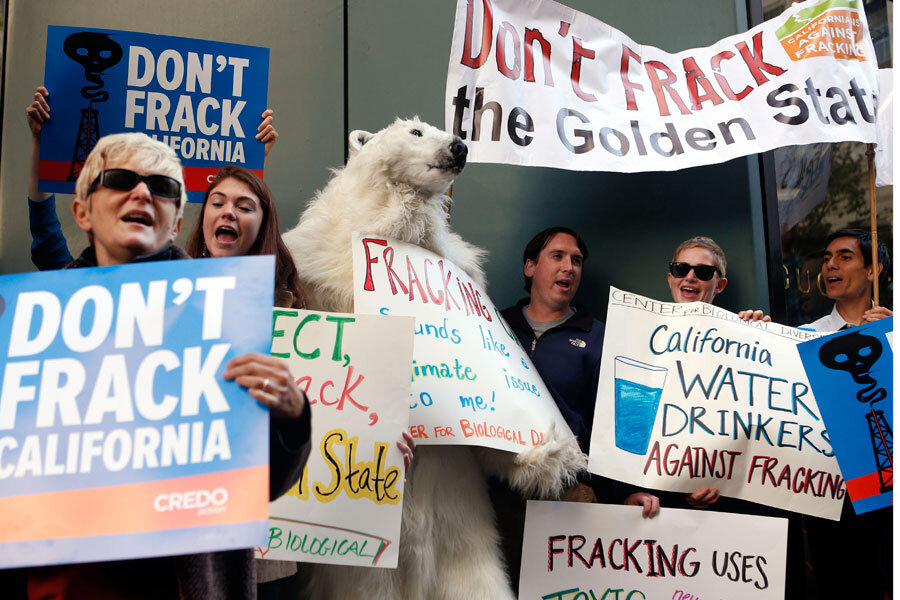Why the federal government stopped fracking off California's coast
Loading...
The federal government must stop approving all offshore oil fracking in California’s Santa Barbara Channel, according to a legal settlement filed Friday in US District Court in Los Angeles.
A lawsuit filed by the Center for Biological Diversity against the US Department of the Interior challenges the department’s practice of “rubber-stamping fracking off California’s coast without engaging the public or analyzing fracking’s threats to ocean ecosystems, coastal communities and marine life…” the environmental nonprofit says in a press release.
Under the settlement, the department’s Bureau of Ocean Energy Management and Bureau of Safety and Environmental Enforcement must cease approving fracking permits immediately and analyze the environmental dangers of offshore fracking by the end of May, as designated under the National Environmental Policy Act. All future permit applications must be publicly accessible and open to review.
This procedure is a far cry from the oil industry’s easy application process of the past. Kristen Monsell, an attorney at the Center of Biological Diversity who worked on the lawsuit, tells The Christian Science Monitor in a phone interview Monday the rubber-stamping was so apparent, that fracking permits were often approved the same day they were submitted.
“Offshore fracking is linked to oil spills, it increases the rate of earthquakes, and it is happening in the Santa Barbara Channel, an area with incredible biodiversity. It’s just unbelievable that they’ve been authorizing this process without any analysis whatsoever,” Ms. Monsell says. “Federal law clearly requires our government to analyze these threats. They can’t just shrug off that obligation.”
These industry-friendly permit practices have been in place for years, say environmental groups. But they were finally revealed when the Environmental Defense Center filed for permit details under the Freedom of Information Act.
“These practices are currently being conducted under decades-old plans with out-of-date or nonexistent environmental analysis,” Brian Segee, an attorney for the Environmental Defense Center, told the Associated Press.
The US Department of the Interior, Bureau of Ocean Energy Management could not be reached immediately for comment.
Monsell doesn’t expect the Interior Department to return to business as usual once the environmental assessments are completed in May. When federal officials finally see the repercussions, they will have no choice but to stop offshore California fracking, she says.
“We think that the settlement is a huge victory for the California coastal environment… It’s a huge victory for the oceans,” Monsell adds. “When the federal government actually take a hard look at the impact of fracking, it will have to stop authorizing the practice all together.”
The settlement pertains only to fracking in the Santa Barbara channel, but Monsell expects that it will send a national message.
“We think this analysis will lead to a permanent ban on the practice,” she adds. “While the settlement agreement is specific to the Pacific outer-continental shelf, it is a total rebuke of the federal government’s hands-off policy.”
A national debate continues over the pros and cons associated with fracking. Last year, the Environmental Protection Agency seemed to indicate that it was safe:
Proponents of fracking rejoiced at the EPA’s announcement that it “did not find evidence that these mechanisms have led to widespread, systemic impacts on drinking water resources in the United States.” Erik Milito, director of Upstream and Industry Operations at the American Petroleum Institute (API), said the victory for oil and gas companies came as no surprise.
“After more than five years and millions of dollars, the evidence gathered by EPA confirms what the agency has already acknowledged and what the oil and gas industry has known,” he said in an API press release. “Hydraulic fracturing is being done safely under the strong environmental stewardship of state regulators and industry best practices.”
But as The Christian Science Monitor reported, the EPA report also included several ways in which "fracking could potentially contaminate drinking water, and said that in a number of cases, water was, in fact, affected. Though cases in which drinking water was impacted were small in number compared with the sample size of cases studied overall, the EPA said the proportion could be inaccurate, a result of insufficient data and other limitations to the study."
Some observers say halting offshore fracking permits doesn't have a major impact, because California hasn't produced much offshore oil lately.
But Monsell disagrees.
“Oil companies have fought tooth and nail against efforts to halt offshore fracking,” says Monsell, so it’s clear they have a future need for it. And the environmental repercussions of offshore fracking – no matter how rare - can’t be overestimated, she adds.
EDC attorney Brian Segee told the Santa Barbara Independent that the settlement had been initially opposed by ExxonMobil and the American Petroleum Institute, whose attorneys argued that the additional permitting requirements could hamper their access to a resource for which the oil companies had already secured lease rights. Likewise, they argued that federal environmental law was far from explicit about such situations.






